Qualcomm talks Snapdragon 820 at MWC 2015Noticia: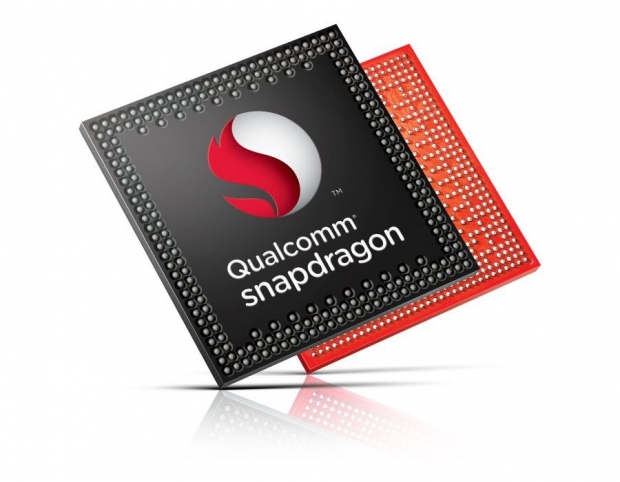
With custom 64-bit CPU core
While some of the first devices based on the Snapdragon 810 are about to hit the global market, Qualcomm has decided to unveil some the first details regarding its next big thing at Mobile World Congress 2015 in Barcelona, the Snapdragon 820 SoC.
Although it did not unveil a lot of details during its keynote at MWC 2015, the company did say that the Snapdragon 820 will be built on a FinFET manufacturing process, so it is either TSMC's 16nm or Samsung's 14nm node.
Qualcomm also noted that the Snapdragon 820 SoC will be part of its new Zeroth platform and feature the first with 64-bit custom Qualcomm ARMv8 CPU core, named the Kyro.
While Qualcomm was unwilling to shed any more specific details regarding that custom Qualcomm CPU core, or the GPU part for that matter, it did say that first samples are expected sometime in the second half of this year.
http://www.fudzilla.com/news/process...20-at-mwc-2015
User Tag List
 Likes: 0
Likes: 0
Resultados 61 a 75 de 196
Tópico: Qualcomm
-
02-03-15, 14:29 #61Tech Ubër-Dominus


- Registo
- Nov 2013
- Local
- City 17
- Posts
- 30,121
- Likes (Dados)
- 0
- Likes (Recebidos)
- 2
- Avaliação
- 1 (100%)
- Mentioned
- 0 Post(s)
- Tagged
- 0 Thread(s)
-
02-03-15, 16:06 #62Tech Ubër-Dominus


- Registo
- Nov 2013
- Local
- City 17
- Posts
- 30,121
- Likes (Dados)
- 0
- Likes (Recebidos)
- 2
- Avaliação
- 1 (100%)
- Mentioned
- 0 Post(s)
- Tagged
- 0 Thread(s)
Qualcomm, Fujitsu and Intel announce biometric security tech
Noticia:Three technology industry heavyweights have new biometric security solutions launching, all are said to offer convenient and secure alternatives to passwords and PINs on your (mobile) devices. Let's have a look through the new biometric security tech solutions being touted by Qualcomm, Fujitsu and Intel to make our device access simpler, quicker and more secure.
Qualcomm Snapdragon Sense ID 3D Fingerprint Technology
Qualcomm has announced Snapdragon Sense ID 3D Fingerprint tech at the MWC 2015. It is described succinctly as "the mobile industry's first 3D fingerprint authentication technology based on ultrasonic technology". The scanning is said to represent a step above the capability and usability of current capacitive fingerprint reading tech.
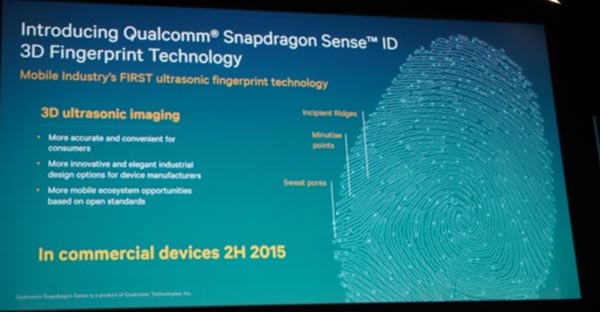
Sense ID 3D uses Qualcomm SecureMSM technology and the FIDO (Fast IDentity Online) Alliance Universal Authentication Framework (UAF) specification to provide password-less authentication for users. The ultrasonic scanner can read through materials such as glass, aluminium, stainless steel, sapphire and plastics – common smartphone construction materials. Also if you hand is a bit grubby, sweaty or sticky – that represents no challenge to the scanner. As suggested by the name the scanner uses sound waves to read a 3D fingerprint – including ridges and sweat pores – far more accurate than a capacitive touch reader.
Qualcomm's new security solution is compatible with all Snapdragon 400 series, 600 series and 800 series processors and will be introduced with the Snapdragon 810 and Snapdragon 425 processors. OEMs are already testing the solution and you should start seeing the tech deployed in commercially available mobile devices later this year.
Fujitsu Iris Authentication
Fujitsu will be showing off a biometric security solution at MWC which authenticates a user via iris scanning. It has built the infrared scanning system into a smartphone prototype and will be showing off this biometric authentication at MWC. Iris scanning is said to be both hard to fool and extremely convenient as one only need to look at one's smartphone screen to unlock it. Fujitsu says that "The pattern of one's iris does not change much at all after the age of two, it is difficult to injure its surface, and is difficult to forge".
Advantages over the use of hands/fingers to unlock a device are quite obvious; if it's cold and you have gloves on, or you are simply doing something else with a spare hand, you can still unlock your phone. Fujitsu will enable the iris authentication to unlock apps or web services too.
Intel TrueKey
Intel's TrueKey was announced earlier in the year but is expected to be shown off working on various devices at MWC 2015. Showing yet another biometric approach Intel uses 'facial math' at its core. Users log into a device as TrueKey remembers unique things about them including the distance between their eyes and nose and other facial signature characteristics.

Further authentication methods can be integrated to bring extra security like the proximity of your mobile to your PC, for example. It's up to the user and Intel is working on the TrueKey app to support Windows PC, Mac, Android, iOS devices and across web browsers Chrome and Internet Explorer.
The TrueKey solution from Intel is said to be easy, secure and private. As well as accessing your device the system can authenticate and auto-fill passwords on your devices for you. Your device will need a front facing camera or added USB camera, which seems to be the only hardware requirement, which is a bonus. If you are interested in the app a free subscription allows for 15 passwords to be stored, more is available with a $19.99pa or $1.99pm subscription.
http://hexus.net/mobile/news/general...security-tech/
-
02-03-15, 16:21 #63Tech Ubër-Dominus


- Registo
- Nov 2013
- Local
- City 17
- Posts
- 30,121
- Likes (Dados)
- 0
- Likes (Recebidos)
- 2
- Avaliação
- 1 (100%)
- Mentioned
- 0 Post(s)
- Tagged
- 0 Thread(s)
Qualcomm's Sense ID Fingerprint Scanning Could Outclass Apple's Touch ID
Noticia: Today, Qualcomm announced its new FIDO-compliant ultrasonic fingerprint scanning technology that can record a much more accurate 3D image of the fingerprint's outer skin layer, compared to fingerprint scanning technologies based on capacitive sensors (such as Apple's Touch ID).
Today, Qualcomm announced its new FIDO-compliant ultrasonic fingerprint scanning technology that can record a much more accurate 3D image of the fingerprint's outer skin layer, compared to fingerprint scanning technologies based on capacitive sensors (such as Apple's Touch ID).
"Mobile devices increasingly store our most valuable and sensitive information, while passwords alone do not provide the protection consumers deserve," said Raj Talluri, senior vice president, product management, QTI.Until Apple's Touch ID arrived, nobody cared enough to use fingerprint scanning for authentication in the consumer space, and the previous low-accuracy technologies proved unpopular.
"Snapdragon Sense ID 3D Fingerprint Technology's unique use of ultrasonic technology revolutionizes biometrics from 2D to 3D, allowing for greater accuracy, privacy and stronger authentication. We are very proud to bring the mobile industry's first ultrasonic-based biometric authentication technology to mobile device manufacturers and their customers, who will benefit from the improved and differentiated user experience."
Even though there have been fingerprint scanning technologies in other devices such as notebooks or even smartphones, Apple did it right not just by using a more advanced and accurate technology that isn't a hassle for consumers to use, but the company also put it exactly in the place where most iPhone users would put their fingers anyway -- the home button.
The high accuracy played a role, but what gave Touch ID a large adoption on the iPhones that supported it was the fact that that the users didn't have to do anything differently than normal, other than setting it up initially.
Although there have been some scares about fingerprint data being easily copied even from online photos, right now that's not a huge concern, because the fingerprint data is tied to the phones themselves. Someone who would want to authenticate with your cloned fingerprint data would also need your phone.
If or when Apple will start letting iOS devices owners authenticate to online services with their fingerprint, that's when we can start getting worried about the fingerprint data being stolen, cloned and spoofed. Consumers would wish that the fingerprint scanning technology is much more advanced in order to make it almost impossible for thieves to replicate that fingerprint data. Fortunately, such a solution is already here, thanks to Qualcomm's just announced Sense ID technology.
Apple's Touch ID uses a capacitive sensor technology that measures the different capacitance values in the ridges and valleys of the user's fingerprint when a charge is applied to the Touch ID circuit. The sensor creates an image of all of those values, applies a cryptographic hashing algorithm to the data, and then stores that hash in the Secure Enclave, a secure hardware zone on the phone's chip.
Apple's Touch ID works quite well in general, although not always. When fingers are wet, sweaty or oily, the accuracy can drop significantly.
Qualcomm's Sense ID technology brings the following advantages over Apple's Touch ID:
It's compliant with the FIDO Alliance's UAF (Universal Authentication Framework). The FIDO standard brings much of the tech industry together behind a single authentication standard meant to replace passwords.
This may not be a major issue initially for Apple users, because they're only using Touch ID to authenticate to the phone and to Apple Pay, but when this sort of authentication is also used for online services, the online world will be forced to use two different standards instead of just one: FIDO and Apple's own standard. This will create fragmentation, and some developers may end up supporting only one of the two standards, to the detriment of the users of the unsupported standard.
Sense ID can work through glass, plastic or metal. This means OEMs can simply put it behind the phone's screen, instead of creating a special button for it. Because many Android OEMs have already removed their buttons from the front of the phone, they had to put the fingerprint scanner on the back of the device.
That's not an ideal place, and it can end up frustrating the phone's owner. If it can be put instead behind the screen's virtual "unlock button," this should work more smoothly. This sort of thing can be done only because Qualcomm uses ultrasonic technology that can penetrate most materials.
Perfectly clean fingers not necessary. For the same reason Sense ID works through glass and metal, the technology can also capture the fingerprint's image through sweat or hand lotion with no issues.
Cloning-proof fingerprint template. Because the ultrasonic technology can penetrate the finger's skin layers at a deeper level, cloning or spoofing the fingerprint should be much harder to achieve from a simple online picture.
There are a few similarities between Qualcomm's Sense ID technology and Apple's Touch ID. For one, they both seem based on a custom version of ARM's TrustZone technology, which represents a "secure world" separated from the "insecure" operating system, where things such as the fingerprint template, passcodes or DRM keys are kept securely. Qualcomm call this zone the "SecureMSM," while Apple calls it the "Secure Enclave." Both technologies send the fingerprint data through a dedicated connection to the secure storage zone.
Qualcomm said that the fingerprint data also stays on the device (so it's not stored in a cloud somewhere), but it's not clear whether it's the actual fingerprint data that is stored, or a hash of it, like Apple's Touch ID.
Qualcomm SecureMSM architecture
Qualcomm's Sense ID technology will be available in devices in the second half of this year and will arrive with chips such as the Snapdragon 810 and Snapdragon 425. With the biggest mobile chip company making such technology, it shouldn't take long before many other smartphones come with fingerprint scanning technology that's at least as good as Apple's Touch ID, helping more people secure their devices in a easy way.
http://www.tomshardware.com/news/qua...-id,28660.html
-
02-03-15, 17:56 #64Tech Ubër-Dominus


- Registo
- Nov 2013
- Local
- City 17
- Posts
- 30,121
- Likes (Dados)
- 0
- Likes (Recebidos)
- 2
- Avaliação
- 1 (100%)
- Mentioned
- 0 Post(s)
- Tagged
- 0 Thread(s)
Qualcomm Unveils 64-Bit Kyro-Based Snapdragon 820 And Zeroth Cognitive Compute Processors
Many of the higher end and flagship devices on tap for the coming weeks and months will sport Qualcomm's Snapdragon 810 processor inside, a 64-bit System-on-Chip (SoC) featuring quad-core ARM Cortex A57 and A53 CPUs. But what's potentially even more exciting is a cognitive platform Qualcomm is working on that will be supported by its forthcoming Snapdragon 820 processor.
More on that in a moment, but first a few details about the chip itself. Qualcomm's Snapdragon 820 is being designed on a leading edge FinFET process node, though the company didn't say if it's using TSMC's 16nm manufacturing process or Samsung's 14nm technology. It also didn't provide speeds or go into technical details, though we know it will be compatible with the ARMv8 instruction set. It will also be based on a new, custom 64-bit CPU core called "Kyro," which will leverage Qualcomm's aforementioned cognitive computing platform called "Zeroth."
image: http://hothardware.com/ContentImages...omm-Zeroth.jpg"Instead of gadgets that you use to help you conduct your daily business, a mobile device will mean something that learns and adapts in real time—even anticipating what you will want to do next," Qualcomm explains. "The foundation for these changes is Qualcomm Zeroth, our first cognitive capable platform, and your copilot for an increasingly connected world."

Put simply, Zeroth represents Qualcomm's attempt to level up the mobile experience by making your smartphone truly smart, along with other mobile devices.
Qualcomm is developing a software platform that can tap into various components to streamline user interaction and become a more helpful companion that learns as it goes. For example, you might point your phone's camera at a street sign and Zeroth will tell you how much further your destination is, and if there are any shops along the way it thinks you might enjoy. Or it could translate a sign when you're traveling abroad.
Other functions are simply about reducing interactions. Instead of manually turning up the volume when you're riding on a train or in a car, your phone will detect such situations by the sound of the engines and raise the volume by itself.
"Our mobile devices already boast an amazing number and variety of high-quality sensors. Always-on awareness and other features like intelligent connectivity will enable next-generation mobile devices to take full advantage of Zeroth cognitive processing," Qualcomm adds.
It's like Siri on steroids, though there are obviously several hurdles to overcome. One is battery life -- the concept behind Zeroth is that the different components are always-on, including your phone's microphone, camera, and so forth. There's also a security and privacy concern there.
Hurdles aside, it will be interesting to see how well Zeroth works what creative things developers come up with.
Noticia:
http://hothardware.com/news/qualcomm...lm2lbOKmgij.99
-
03-03-15, 17:19 #65Tech Ubër-Dominus


- Registo
- Nov 2013
- Local
- City 17
- Posts
- 30,121
- Likes (Dados)
- 0
- Likes (Recebidos)
- 2
- Avaliação
- 1 (100%)
- Mentioned
- 0 Post(s)
- Tagged
- 0 Thread(s)
Find Out If Qualcomm’s Still Got It; Exynos 7420 vs Snapdragon 810 Benchmarks Analyzed
With the launch of Samsung’s Galaxy S6 and S6 Edge, and HTC’s One M9, one of the main question on everyone’s mind was which device will perform better. After all, both of them come with industry leading chipsets on board, namely the Snapdragon 810 and the Exynos 7420. Samsung caused quite a stir around the mobile world when it became rumored that the Korean manufacturer was choosing to drop Qualcomm’s jewel in crown with one of its own in house SoCs. And it had every reason to do so. After all, the Exynos 7420 is manufactured on Samsung’s very own 14nm FinFET manufacturing process, giving it not only significant performance, but also power enhancements. So if you’re wondering how the two stack up against each other, and against Apple’s A8 (found in the iPhone), take a look at the benchmarks below to find out.
 The First Exynos 7420 Vs Snapdragon 810 Benchmarks Are Here – Samsung Knocks Qualcomm Out Of The Park
The First Exynos 7420 Vs Snapdragon 810 Benchmarks Are Here – Samsung Knocks Qualcomm Out Of The Park
Starting with GeekBench multi core, Samsung’s 14nm processor manages to take a solid lead over Qualcomm’s Snapdragon 810, something that will continue for the majority of the benchmarks that we’ll be sharing with you today. While both the processors use the same Cortex cores (A57 and A53) in eight sets, the Snapdragon 810 clocks at a higher speed of 2.0 GHz. The Exynos 7420 on the other hand has a maximum clock speed of 1.5 GHz, which lets Samsung keep the thickness on the Galaxy S6 to a minimum
 While the Exynos still beats the Snapdragon in Geekbench Single Core, Apple’s A8 still is on the top when it comes to singe core performance. This can most likely be attributed to the Cupertino manufacturer’s superior software + hardware integration and shows us that while behind in some areas, the iPhone is still a strong contender for SoC specifications.
While the Exynos still beats the Snapdragon in Geekbench Single Core, Apple’s A8 still is on the top when it comes to singe core performance. This can most likely be attributed to the Cupertino manufacturer’s superior software + hardware integration and shows us that while behind in some areas, the iPhone is still a strong contender for SoC specifications.
 Moving towards more CPU performance, the Exynos 7420 leads the Snapdragon 810 by a percentage margin of 19 in integer performance, a critical aspect of CPU performance. The A8 still manages to top the Exynos 7420 over here however, showing us once again the relative strength of Apple’s software integration on the iPhone.
Moving towards more CPU performance, the Exynos 7420 leads the Snapdragon 810 by a percentage margin of 19 in integer performance, a critical aspect of CPU performance. The A8 still manages to top the Exynos 7420 over here however, showing us once again the relative strength of Apple’s software integration on the iPhone.
 Coming towards multi core however, Samsung’s 14nm FinFET manages to nearly double its numbers over the iPhone’s A8 and also once again takes a clear lead over the Snapdragono 810. This difference most likely results from overall improved efficiency which results from the 14nm process. These single and multi core results become even more evident in floating point cores, shown below.
Coming towards multi core however, Samsung’s 14nm FinFET manages to nearly double its numbers over the iPhone’s A8 and also once again takes a clear lead over the Snapdragono 810. This difference most likely results from overall improved efficiency which results from the 14nm process. These single and multi core results become even more evident in floating point cores, shown below.
-
22-03-15, 17:22 #66Tech Ubër-Dominus


- Registo
- Nov 2013
- Local
- City 17
- Posts
- 30,121
- Likes (Dados)
- 0
- Likes (Recebidos)
- 2
- Avaliação
- 1 (100%)
- Mentioned
- 0 Post(s)
- Tagged
- 0 Thread(s)
Qualcomm’s Snapdragon 815 Runs Cooler Than The Snapdragon 810
[QUOTE]Leading mobile chipset maker Qualcomm and its upcoming high end chipsets, the Snapdragon 820 and the Snapdragon 815 are expected to be manufactured on the 14 nm FinFET and 20 nm respectively, which will no doubt result in both chipsets displaying impressive processing capabilities and energy efficiency. The smaller lithographic process will also mean that both SoCs are able to keep their temperatures way under the limits. While the benchmarking reports of the Snapdragon 820 have yet to be leaked, Stjsgadgets-portal has managed to publish the thermal performance of the Qualcomm Snapdragon 815, and in comparison to the Snapdragon 810 and 801, the unreleased chipset is far superior.

Thermal efficiency at its finest
According to the source, all of the three chipsets were placed under a controlled environment with the following variables present:
- 5 inch screen size
- 1080p resolution
- 3 GB of RAM
- No cellular antenna
With the 5 inch screen size rendering the 1080p resolution, an impartial thermal review could be posted of all the three chips. One of the reasons why there was no cellular antennas present in the devices where the three chipsets were placed was because the absence of the radio would force the chips to run a little warmer, thus displaying results under the worst case ‘real world’ scenario. The intensive application that was going to test the thermal performance of the SoCs was none other than Asphalt 8. According to the report, given below are the results after the chipsets were subjected to the taxing video game for an equal amount of time. Please note that all results present below are in degrees Fahrenheit while the graphical representation has been given in degrees Celsius.
- Snapdragon 815: 100.4 degrees Fahrenheit
- Snapdragon 801: 107.6 degrees Fahrenheit
- Snapdragon 810: 111.2 degrees Fahrenheit

The superior architecture of the Snapdragon 815 seems to be working well in Qualcomm’s favor as the Snapdragon 815 displayed astounding thermal results. Surprisingly, the company’s Snapdragon 810 performed the worst out of all the three, even though Snapdragon 801 is two generations older compared to its successor. Since heat is considered to be the natural born enemy of computer components, overheating of a smartphone chipset will definitely have irreparable effects on the remainder of the components, and the overall battery life of the device.
The Snapdragon 815’s octa-core processor will be supplemented by the company’s Adreno 450 GPU and the first handsets sporting the SoC are expected to arrive in Q4, 2015. Looks like Qualcomm has finally eradicated the overheating issues on its next generation products, which was a concern for several device makers and consumers alike.
-
24-03-15, 14:57 #67Tech Ubër-Dominus


- Registo
- Nov 2013
- Local
- City 17
- Posts
- 30,121
- Likes (Dados)
- 0
- Likes (Recebidos)
- 2
- Avaliação
- 1 (100%)
- Mentioned
- 0 Post(s)
- Tagged
- 0 Thread(s)
Qualcomm’s Snapdragon 620 and 615 are Put to the Test
Apart from Qualcomm rolling out its high-end Snapdragon 820 and 815 in the near future, the leading mobile chip maker for smartphones and tablets will also be releasing its Snapdragon 620 and 615 SoCs, which are designed to be placed in mid-ranged devices. Earlier, a thermal test concerning the Snapdragon 815, 810 and 801 was carried out in an environment where the variables remained constant, and the company’s Snapdragon 815 displayed the best thermal results compared to the remaining two products. Now, according to a source, Qualcomm has apparently tested out its Snapdragon 620 and 615 SoCs and published both of their results.

Snapdragon 620 runs cooler than the Snapdragon 615
Similar to the previous tests carried out, both chipsets were subjected to an environment, where all the variables remained constant in order to get the most accurate result possible. The variables have been given below:
- 4.7 inch IPS display
- 720p resolution
- 1.5 GB of RAM
- No cellular antenna or radio
Just like before, the absence of the cellular radio will allow the SoCs to run cooler than they normally would, resulting in temperature readings that will be far more accurate than if they were added in the first place. While there were different hardware specifications used to conduct the thermal tests, one primary change that was brought to the table was that instead of using Asphalt 8 as the primary mobile gaming application, Mordern Combat 5: Blackout was used (the mobile gaming title is not to be confused with the popular ‘one on one’ title: Mortal Kombat).
Given below are the thermal results of each chipset. A graphical representation of both products have also been provided:
- Snapdragon 620: 107.6 degrees Fahrenheit
- Snapdragon 615: 114.8 degrees Fahrenheit

The higher performing chipset displayed better thermal efficiency compared to the Snapdragon 615. In addition to this, the source has also mentioned that the Snapdragon 620 cooled down instantly after the benchmarking period was over. However, there was erratic behavior shown by the lower performing chipset when it came to cooling down, but Qualcomm will most likely make the necessary tweaks when the SoCs are about to be incorporated in to smartphones. Qualcomm’s high-end chipsets that will be released alongside the Snapdragon 620 and 615; the Snapdragon 820 and 815 will be manufactured on the 14 nm FinFET and 20 nm process, respectively. It is expected that the company will be releasing its offerings in Q4, 2015.
-
24-03-15, 15:20 #68Tech Ubër-Dominus


- Registo
- Nov 2013
- Local
- City 17
- Posts
- 30,121
- Likes (Dados)
- 0
- Likes (Recebidos)
- 2
- Avaliação
- 1 (100%)
- Mentioned
- 0 Post(s)
- Tagged
- 0 Thread(s)
A New Dawn Approaches As Qualcomm Looks To Samsung For 14nm Chip Supplies
With the launch of the Galaxy S6 and S6 Edge, Samsung entered a new era of mobile manufacturing. Not only did the devices feature massive design upgrades and overhauls, but debuted with Samsung’s home grown, industry first, 14nm Exynos 7420 chipset, making the Galaxy S6 duo the first smartphones in the market to come with the benefits associated with the advanced manufacturing process. But with Samsung’s FinFET debut, we can surely expect Apple and Qualcomm to have their replies ready soon too. And if several rumors are to be believed, then both of them might end up relying more on Samsung than they’d originally prefer.

Samsung To Reportedly Manufacture 14nm Chipsets For Apple And Qualcomm?
While Samsung did go ahead and launch its flagship devices with the 14nm Exynos 7420 on board, even after their launch, rumors and speculations remained ripe about the manufacturer’s ability to completely bring them into production on mass scale. One analyst in particular, Mark Lee of Bernstein Research claims that while Samsung is able to bring 14nm chipsets into production, their yield still proves to be an issue for the South Korean giant, which has been one of the primary reasons Apple still chose to place only 40% of its A9 orders to Samsung.
If Samsung’s having yield problems of its own, then it could spell trouble for the company’s heavily hyped Galaxy S6 and S6 Edge launch at the start of this month. Not only this, but given alleged reports that Qualcomm’s been having trouble solving the heating issues on the Snapdragon 810, then the question remains; how long will it take 14nm for smartphones to be adopted on a mass scale? Feng blog further goes on to report that TSMC itself is having problems with the 16nm yield, so looks like even Apple isn’t in the clear this time around.
Looking at chipsets and manufacturing processes for smartphones, while reduced die size does end up offering significant performance and power consumption benefits, are those benefits worth it if our devices get delayed? After all, devices that run on chipsets older than this year’s still do manage to run nearly everything there is to run out there. The key player in this entire puzzle is Samsung however; if the Korean manufacturer is able to solve its yield issues, then various sources suggest that Qualcomm itself might see Samsung become a supplier. Where all of this leaves ARM’s dominance in core design and architecture? Only time will tell, as Samsung and Qualcomm both have plans for custom cores. Stay tuned, we’ll keep you updated.
-
27-03-15, 13:56 #69Tech Ubër-Dominus


- Registo
- Nov 2013
- Local
- City 17
- Posts
- 30,121
- Likes (Dados)
- 0
- Likes (Recebidos)
- 2
- Avaliação
- 1 (100%)
- Mentioned
- 0 Post(s)
- Tagged
- 0 Thread(s)
Qualcomm teams up with Microsoft
Noticia: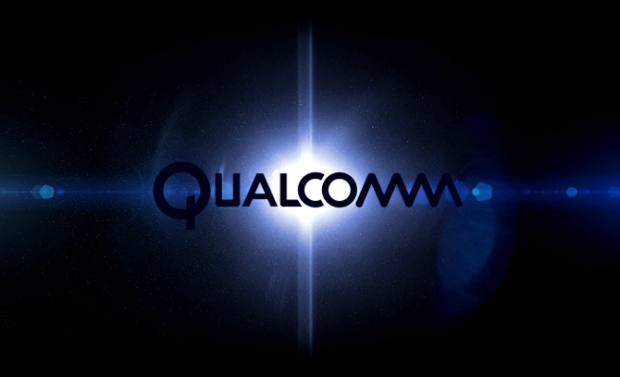
DragonBoard 410c development kit in the works
Qualcomm has teamed up with Microsoft's Windows 10 to create a DragonBoard 410c development kit.
The big idea is that it will help both the companies develop Internet of Things projects.
Qualcomm will support Windows 10 in its DragonBoard 410c development board, which is powered through the company's Qualcomm Snapdragon 410 processor.
The DragonBoard is a high performance, low cost ARM board, which has capabilities that can outperform quite a lot of board on the market. The board comes equipped with Wi-Fi, Bluetooth, and GPS.
It can power up Windows 10 operating systems even if it is tiny and could be used to power a range of machines like robots, camera, medical devices, wearable tech, vending machines, and casino gaming machines.
Qualcomms senior vice president of products Jason Bremner said that Qualcomm Technologies continues to offer the mobile device and development community the foundation and resources they need to build their portfolio of Windows devices across smartphones, tablets and IoE applications.
"We are thrilled to demo DragonBoard 410c running Windows 10 IoT at WinHEC. DragonBoard 410c is an ARMv8-based development platform which is designed to support a wide array of embedded computing and IoE devices, drivers and application development."Internet of things
Microsoft representative, Kevin Dallas stated that the company is quite hopeful to develop the Internet of Things with their advanced Azure cloud platform.
Dallas stated that having Qualcomm's developer board will help device builders to make new services based on the cloud, which will let the IoT phenomenon progress in the future.
"Combining Windows 10 with the performance of Qualcomm Snapdragon 410 processors will help the ecosystem realize robust, feature-rich use cases and enable developers to quickly commercialise their hardware products," he said.
http://www.fudzilla.com/news/motherb...with-microsoft
-
30-03-15, 13:52 #70Tech Ubër-Dominus


- Registo
- Nov 2013
- Local
- City 17
- Posts
- 30,121
- Likes (Dados)
- 0
- Likes (Recebidos)
- 2
- Avaliação
- 1 (100%)
- Mentioned
- 0 Post(s)
- Tagged
- 0 Thread(s)
Qualcomm Delays Snapdragon 815 Launch to Not Hurt the Sales of 810-Powered Smartphones
Qualcomm had a pretty bad start of the year with Snapdragon 810 facing overheating issues. While we saw some earlier rumors coming from the insider sources about these problems, things got pretty out of control after a test model of HTC One M9 powered by 810 chipset reached to abnormal 132 degrees Farenheit. Although HTC has managed to solve the problem by sending a software update, consumers don’t really seem satisfied. Not only consumers, but manufacturers also seem a little uncertain about Qualcomm’s chips. Which brings us to Qualcomm’s next Snapdragon 815 processing chip that the company, as we earlier reported, is claiming to be cooler than the Snapdragon 810 and 801.

Octa-core Snapdragon 815 leaked details:
Qualcomm Snapdragon 815 is going to be the savior chip for Qualcomm which justifies the company putting a lot of buzzword and no actual details, building up the curiosity around it. Latest Snapdragon 815 leaked details reveal that the upcoming Qualcomm chip will feature four Cortex A72 cores and another four Cortex A53 cores using the favorite big.LITTLE technique.
This architecture of eight cores will enable the A72 for heavy tasks keeping the Cortex A53 cores for lighter jobs. According to tipster, Qualcomm is employing the next-gen Adreno GPU (450?) in the chipset build using the FinFet process. This report’s sources also claim that Qualcomm “may tweak the cores to boost performance.”
Earlier details of the chip had indicated that 815 SoC would include LDDR4 RAM and MDM9X55 LTE-A Cat.10 modem. As far as the delays in the launch of Snapdragon 815 are concerned, the source claims,Qualcomm is delaying the launch of Snapdragon 815 mainly because the company doesn’t want to hurt the sales of the 810 powered smartphones in the market such as the HTC One M9 and the LG G Flex 2.Snapdragon 810 is used by many current / upcoming smartphones including HTC One M9, LG G Flex 2, LG G4, Sony Xperia Z4, and others.
– Source: GizmoChina
-
31-03-15, 13:49 #71Tech Ubër-Dominus


- Registo
- Nov 2013
- Local
- City 17
- Posts
- 30,121
- Likes (Dados)
- 0
- Likes (Recebidos)
- 2
- Avaliação
- 1 (100%)
- Mentioned
- 0 Post(s)
- Tagged
- 0 Thread(s)
There is no Snapdragon 815, Qualcomm confirms
Noticia: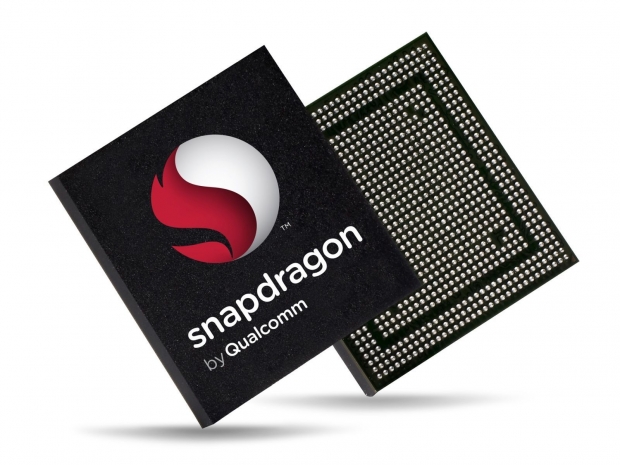
And there never was
A lot of rumours regarding an alleged upcoming Qualcomm Snapdragon 815 SoC have been floating around, and now the chipmaker has informed us that that no such chip exists.
Qualcomm's Senior Director of Public Relations Jon Carvill told Fudzilla that there is no Snapdragon 815 in the works:
Carvill was clear:
“There are no plans for a Snapdragon 815 processor.”
Snapdragon 815 filed under creative journalism
The Snapdragon 815 rumours spread like wildfire, but since they didn’t make much sense, we decided not to carry them. Basically the alleged Snapdragon 815 was supposed to be a 16nm SoC with four Cortex-A72 and Cortex-A53 cores, but the rest of the spec was hard to swallow.
Long story short, there is no such thing as a Snapdragon 815. The company never had such a product, and if you know a thing of two about SoC development, it takes years to make a new SoC design from scratch – you don’t just design a new one for a new node out of the blue.
It would be very convenient if the company managed to pull off something like this, but it’s simply not possible.
Qualcomm’s next flagship is the Snapdragon 820
Now that we debunked this rumour, we should focus on Qualcomm’s real next generation flagship SoC – the Snapdragon 820.
The company mentioned the Snapdragon 820 at the Mobile World Congress in Barcelona, but it looks like that it will be a while before we see this chip shipping in actual devices. Qualcomm expects the new part to sample sometime in the second half of the year, so in the best case scenario we might see the first devices by the end of the year, but most products based on the new chip will start shipping in early 2016.
The 20nm Snapdragon 810 is not overheating, it works just fine, and we tested it inside the HTC One M9. We can confirm that it ends up significantly faster than the Snapdragon 801, which we had a chance to try in a few phones.
http://www.fudzilla.com/news/mobile/...lcomm-confirms
-
02-04-15, 13:30 #72Tech Ubër-Dominus


- Registo
- Nov 2013
- Local
- City 17
- Posts
- 30,121
- Likes (Dados)
- 0
- Likes (Recebidos)
- 2
- Avaliação
- 1 (100%)
- Mentioned
- 0 Post(s)
- Tagged
- 0 Thread(s)
Snapdragon 820 to end up on Samsung’s 14nm node?
Noticia:
TSMC lagging by at least one quarter
Qualcomm’s next-gen Snapdragon 820 may not only be the company’s first FinFET part, but the first processor manufactured by Samsung rather than TSMC.
According to Digitimes Research, TSMC is simply late to the party and its FinFET node is lagging behind Samsung’s by about one quarter. However, Qualcomm is expected to use more than one foundry, just like Apple – so it might move more than 50% of its FinFET SoC orders to Samsung, while still using TSMC.
Samsung attracting more business
In addition to Qualcomm, Samsung is rumoured to be on track to win more contracts from other chip designers such as MediaTek, AMD and Nvidia. Digitimes analysts believe these companies could shift part of their orders to Samsung in 2015 and 2016.
In addition to FinFET, TSMC is also losing some 28nm orders from major designers, namely MediaTek and Qualcomm, to UMC and other foundries.
This trend is usually associated with strong demand in the very competitive Chinese market, as mobile SoC churners are trying to get the best possible value for money on every single unit.
Qualcomm’s high-end blues
The Snapdragon 810 proved to be a controversial part even before we got a chance to see it in any devices. It was rumoured that the 20nm part was experiencing thermal issues and throttling, unlike Samsung’s Exynos 7420, built on the company’s cutting edge 14nm node.
However, much of this was FUD. While the Snapdragon 810 isn’t perfect, it’s not necessarily a bad chip – it’s just not as efficient and cool as the Exynos 7420 because it is built on the planar 20nm node.
Digitimes reckons shipments of high-end Qualcomm SoCs in 2015 could take a big hit and drop to about 100 million units. Samsung’s decision to use an in-house SoC for the Galaxy S6 obviously has significant implications for Qualcomm, but the company does not appear to be overly concerned.
While Samsung’s Exynos 7420 is a technological marvel, it’s also the result of good timing and some good luck. Qualcomm is currently stuck at an inferior node and this year it’s using reference ARM cores, but the company is expected to use custom ARMv8 cores in the Snapdragon 820, along with a new node.
On another note, rumours that Qualcomm could launch a FinFET part earlier than expected, in the form of the Snapdragon 815, were debunked earlier this week.
http://www.fudzilla.com/news/process...ng-s-14nm-node
-
09-04-15, 06:31 #73Moderador


- Registo
- Feb 2013
- Local
- Santo Tirso
- Posts
- 12,674
- Likes (Dados)
- 30
- Likes (Recebidos)
- 208
- Avaliação
- 4 (100%)
- Mentioned
- 7 Post(s)
- Tagged
- 0 Thread(s)
It is a bad week for Qualcomm
ot only has the NVIDIA sueball pitch been judged to be in play and will continue to run but nowaccording to news The Register has heard Samsung may be using their own in-house ARM processors for their next products. The rumour is that they have spend four years developing an ARM processor from the ground up which will make it much less likely that Qualcomm will be able to sell their next generation 64 bit Snapdragon Kyro processor to Samsung, which is after all a modified ARM v8-a chip as opposed to a custom built processor. Qualcomm does have other customers than Samsung, including HTC, Amazon and LG who might be interested in the new Snapdragon 820 but it does look bleak for their next generation processor. The only leverage Qualcomm has now is thatSamsung will likely be the ones fabbing many of the new Snapdragon 820's, perhaps they can strike a deal for some lower cost mobile devices once Kyro matures.
"Samsung will join Apple and other mobile semiconductor rivals in producing chips powered by homegrown, proprietary application cores in 2016, according to a new report."Ryzen R5 3700X / Noctua NH-D15 / B550 AORUS ELITE V2 / Cooler Master H500 Mesh / 16Gb DDR4 @ 3800mhz CL16 / Gigabyte RTX 2070 Super / Seasonic Focus GX 750W / Sabrent Q Rocket 2 TB / Crucial MX300 500Gb + Samsung 250Evo 500Gb / Edifier R1700BT
-
13-04-15, 12:58 #74Tech Ubër-Dominus


- Registo
- Nov 2013
- Local
- City 17
- Posts
- 30,121
- Likes (Dados)
- 0
- Likes (Recebidos)
- 2
- Avaliação
- 1 (100%)
- Mentioned
- 0 Post(s)
- Tagged
- 0 Thread(s)
Qualcomm chip business worthless
Noticia: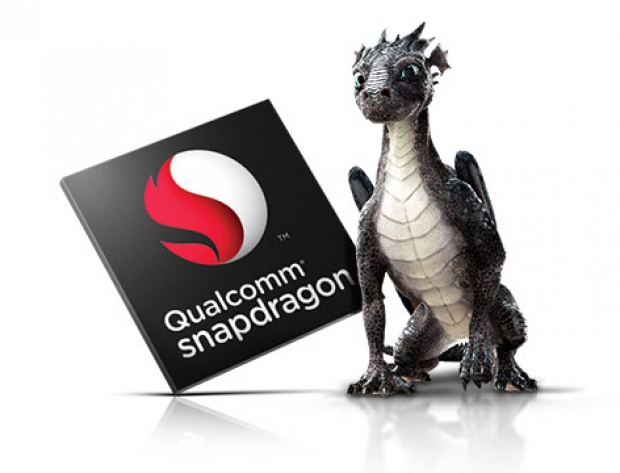
Spin it off warns sctivist investor
Qualcomm has been told to spin-off its "worthless" chip unit away from its patent-licensing business in order to boost sliding stock prices.
According to the Wall Street Journal Jana Partners is calling on Qualcomm to cut costs, accelerate stock buybacks and make changes to its executive pay structure.
Qualcomm has already said it would buy back up to $15 billion in shares and raise its quarterly dividend to 48 cents per share from 42 cents.
But Jana is one of Qualcomm's largest shareholders, having purchased a stake in the chip maker worth over $2 billion.
It said that the buyback program is a "positive step," but Qualcomm should do more to capitalize on its dominant position in the chip market. At the moment Jana thinks that Qualcomm's chip business "is essentially worthless" at the firm's present market value.
This is a bit strange as Qualcomm is one of the world's largest makers of chipsets used in mobile devices. The firm also supplements its income through patent-licensing deals.
Samsung, a long-standing customer of Qualcomm, dropped the company's chips from its latest Galaxy S6 flagship smartphone earlier this year and instead opted for an internally developed processor.
http://www.fudzilla.com/news/process...ness-worthless
-
14-04-15, 07:32 #75Tech Ubër-Dominus


- Registo
- Nov 2013
- Local
- City 17
- Posts
- 30,121
- Likes (Dados)
- 0
- Likes (Recebidos)
- 2
- Avaliação
- 1 (100%)
- Mentioned
- 0 Post(s)
- Tagged
- 0 Thread(s)
Qualcomm responds to spin-off proposal
Noticia: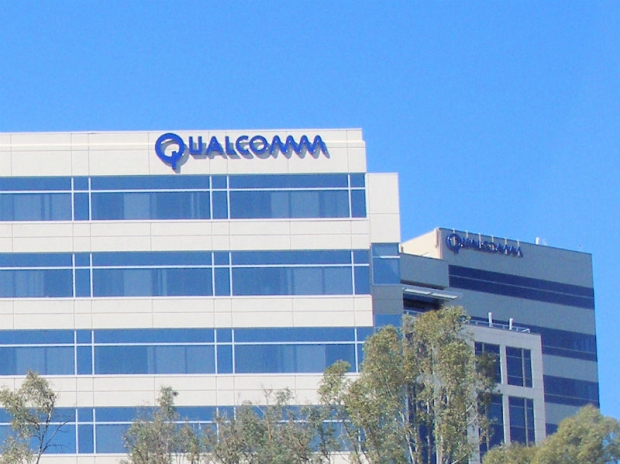
Thanks but no thanks
Qualcomm has issued a statement in response to an idea floated by Jana Partners a couple of days ago.
Jana Partners, a major Qualcomm shareholder, boldly stated that the company’s chip unit is “worthless” and should be spun off into a new entity. Jana argues that Qualcomm’s patent licensing business wold do well on its own, thus boosting the stock price. Qualcomm responded by saying that the company’s opportunities remain strong, with long-term growth potential beyond the smartphone space:
“Our innovations have made smartphones the most pervasive technology of our time. They come to market through our inclusive licensing program and our cutting-edge chipsets and continue to play an integral role in the expansion of the mobile industry. We are now bringing the benefits of mobile technologies to new areas such as automotive, healthcare, networking, smart homes, smart cities, and wearables among others.”
The chipmaker went on to point out that its board of directors and management periodically review the corporate structure, but prior reviews have concluded that the current model creates more value for stockholders than an alternative corporate structure.
It is basically a polite way of telling Jana Partners that this would be a very bad idea in the long run. Qualcomm’s IP doesn’t fall from the sky, it’s the result of painstaking work and hundreds of millions of dollars’ worth of R&D. It’s made possible by strong chip sales, not the other way around.
http://www.fudzilla.com/news/process...n-off-proposal
Informação da Thread
Users Browsing this Thread
Estão neste momento 1 users a ver esta thread. (0 membros e 1 visitantes)




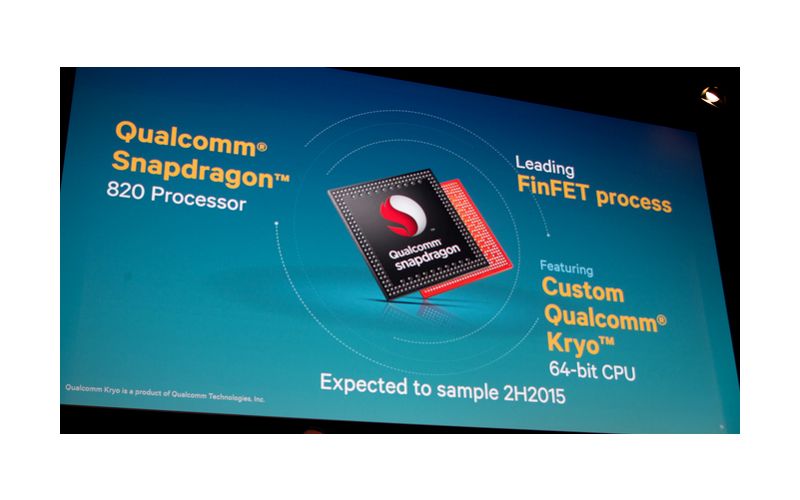


 Responder com Citação
Responder com Citação


Bookmarks